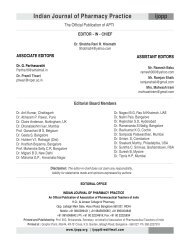Oct-Dec, 2011 - Indian Journal of Pharmacy Practice
Oct-Dec, 2011 - Indian Journal of Pharmacy Practice
Oct-Dec, 2011 - Indian Journal of Pharmacy Practice
- No tags were found...
Create successful ePaper yourself
Turn your PDF publications into a flip-book with our unique Google optimized e-Paper software.
Satyanarayana V - Evaluation <strong>of</strong> the Impact <strong>of</strong> a Therapeutic Management and Effect <strong>of</strong> Pharmacist Intervention on Children with Asthmathe mild intermittent category, 24% were in mild persistentand 10% were in moderate persistent category. Severepersistent cases had not been reported during the study period(Figure 2). Among infants, 20% have wheezing with onlyupper respiratory tract infections (URTIs), and 60% no longerhave wheezing by age 6 years. As Martinez et al have pointedout; however, many <strong>of</strong> these children are "transient wheezes"whose symptoms subside during the preschool or early school30, 31years . They tend to have no allergies, although their lungfunction is <strong>of</strong>ten abnormal. These findings have led to the ideathat they have small lungs.Fig. 2: Saverity <strong>of</strong> AsthmaSeverity <strong>of</strong> asthma is categorized based on the NAEPP(National Asthma Education and Prevention Programme) guidelinesIn the present study 50 prescriptions are analyzed before theintervention, and based in the data collected in the preintervention period an intervention strategy was designed inconsultation with clinical staff <strong>of</strong> the department. As a part <strong>of</strong>intervention strategy interpersonal communication wasimproved, the seminars are arranged to detail on drug useproblems based on the pre intervention data. The clinical staffis impressed upon the need <strong>of</strong> improving where evernecessary to promote rational drug use and minimize drug useproblems. In post intervention period again 50 prescriptionsare examined and the full data are analyzed statistically.Number <strong>of</strong> drugs prescribed in the pre intervention study was330 and 283 in the post intervention study. Finding <strong>of</strong> theresult indicates there is no significant reduction in the number<strong>of</strong> drugs prescribed. It has reported that average number <strong>of</strong>drugs prescribed per prescriptions is 6 in both pre interventionand post intervention studies. During pre intervention periodnumber <strong>of</strong> drugs prescribed in generics is 220 where as in postintervention period it is 227. However there is no significantin post intervention period. During pre intervention periodnumber <strong>of</strong> tablets prescribed is 110 reduced to 74 in postintervention period. (Table No 3 & Figure 3).We have observed that there is no significant improvement inthe number <strong>of</strong> nebulizers, cough syrups and oxygenTable 3: Prescription Analysis (I) by pre-intervention andpost-intervention dataPrescriptions Analysis Pre Postintervention interventionTotal number <strong>of</strong> prescriptions 50 50analysedTotal number <strong>of</strong> drugs prescribed 330 283Average number <strong>of</strong> drugs per 6 6prescriptionsNumber <strong>of</strong> drugs prescribed bed in 220 227genericsPercentage <strong>of</strong> drugs prescribed in 440 454genericsNumber <strong>of</strong> antibiotics prescribed 100 92Percentage <strong>of</strong> antibiotics prescribed 200 193Number <strong>of</strong> injections prescribed 110 74Percentage <strong>of</strong> tablet to prescribed 220 148Number <strong>of</strong> neublization prescribed 100 100Percentage <strong>of</strong> neublization prescribed 100 100Number <strong>of</strong> cough syrups prescribed 22 19Percentage <strong>of</strong> cough syrups prescribed 44 38Number <strong>of</strong> O2inhalation prescribed 50 50Percentage <strong>of</strong> O inhalation prescribed 100 1002Number <strong>of</strong> irrational prescribed 161 93Fig. 3: Prescription Analysis (I) by pre-intervention andpost-intervention dataprescribed between pre intervention and post interventionstudies. During pre intervention period number <strong>of</strong> irrationalprescribing reported was 161, but after intervention it wassignificantly reduced to 93. (Table No 4 & Figure 4).Naeti Suksomboon et al concluded that there was a significantdecreased in the number <strong>of</strong> drug related problems in the active<strong>Indian</strong> <strong>Journal</strong> <strong>of</strong> <strong>Pharmacy</strong> <strong>Practice</strong> Volume 4 Issue 4 <strong>Oct</strong> - <strong>Dec</strong>, <strong>2011</strong> 43
















